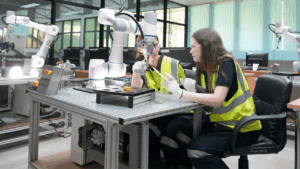
The role of a Certified Environmental Professional covers a wide range of career paths. Ademola Adekunle, Environmental Engineer and EPt (Environmental Professional in-training) knows this to be true with over 8 years of experience in the environmental sector. His current role as Research Officer at National Research Council Canada allows him to work on a number of projects in the Energy, Mining and Environmental field, including projects that develop new technologies. Holding a Ph.D. focused in bioenvironmental engineering, Ademola carries out research and development of new environmental technologies spanning remediation, water quality monitoring, renewable energy domains as well as policy and regulation research.
What can an environmental professional do?
Particularly in North America, one of the most popular job duties of environmental scientists has to do with environmental remediation. This is because, amongst other human activities, the advanced natural resource exploitation in this area creates significant disturbances to ecosystems and leads to the propagation of residual materials beyond the exploitation areas. When the level of the contaminants rises above regulatory limits, toxicity to living organisms as well as human ensues, and environmental remediation which entails the removal of the identified contaminants becomes a necessity.
This process of remediation can be a very expensive process and may take several years to complete. It is therefore rather prudent to continuously monitor toxicity due to the propagation of residual materials before it becomes a problem and remediation is needed. In water bodies, this toxicity monitoring is usually done using standard methods that employ microorganisms, bioluminescent bacteria, daphnia, algae or fish, etc. T
hese standard methods are inefficient because they are laborious, done off-site (hence an increased chance of sample compromise), take several hours to days to complete and can be expensive. The development of inexpensive real-time monitoring technologies/solutions for early detection of toxicity is, therefore, a gap that needs to be filled.
How can environmental professionals help?
As an environmental bioengineer, Ademola currently works on developing a solution to fill this gap at the National Research Council of Canada using the microbial fuel cell (MFC) technology. The MFC technology is an inexpensive, low maintenance autonomous biological system that can be adapted for real-time monitoring of environmental conditions.
This approach of environmental monitoring using biological systems (also referred to as biosensing) is not exactly new. The basic principle in biosensing is that biological responses are converted to measurable signals, which are then used to detect and validate the presence of organic and inorganic environmental pollutants as well as quick changes in their concentration.
Since biosensors can be inexpensive, compact, and easily deployable on-site, they provide several advantages over the traditional methods of analyses. In particular, the MFC-based biosensing technology provides advantages such as a long lifespan, little to no maintenance, simple design, and low cost. The MFC-based technology depends entirely on the activity of microorganisms, which can transfer electrons from their metabolism/respiration to an electron acceptor. These microorganisms are referred to as electroactive microorganisms.
In general, the electron acceptor would be a physical material (e.g., carbon electrodes), and the potential difference between this electron acceptor and another electrode can be measured. It, therefore, follows that a change in the concentration of compounds/contaminants in the environment of the biosensor will interfere with the anodic electron transfer by acting as electron acceptors or donors.
This change can be detected quickly and can serve as a prompt for further definitive investigation. In essence, this MFC based sensing technology can act as an early warning device.
Getting Ideas Off the Ground
As with any technology, tests in the laboratory are essential for validating ideas and as a proof of concept, but practical utilization is another story entirely. This, in Ademola’s opinion, is one of the most critical works of an environmental professional: creating environmental solutions that really work.
Over the last few years, Ademola’s team has been working on deploying and validating the MFC based sensing technology on the field. This progression to field usage is fraught with numerous but exciting challenges, including the removal of dependence on non-renewable energy sources for the biosensor’s operation and the transmission of data. As environmental engineers looking to solve this energy challenge in a sustainable way, the usage of a biobattery could be enormously helpful.
As part of the essential criteria for developing an effective biobattery, it should require little maintenance and would be able to last for several years.
Luckily, since the current generated by the microbes in an MFC, although very small, can be stored in a system of capacitors, Ademola has also been working on developing an MFC-based biobattery.
An essential first step was determining which slow release of naturally occurring biodegradable materials would be suitable.
In previously published works, Ademola’s team have been able to demonstrate the feasibility of using natural biodegradable materials such as humus, peat moss, cattle manure, and sawdust as the anolyte in this type of biobattery. However, Ademola continues to work on reshaping the current generated into a form suitable for powering electronic components. Even as it is, the biosensor developed by his team is already being tested in the field with great results. However, the ultimate goal of this project is to form a genuinely sustainable autonomous remote-sensing technology.
Takeaways
In general, as in Ademola’s perspective, an environmental career pathway can be very multifaceted. A typical week for Ademola can fluctuate between spending long hours in the field one day to programming the next day to developing new technologies the next day.
Ademola believes that with the advent of computers, the roles of environmental professionals as well as the possibility, and avenues to pursue an environmental career has expanded significantly, from outright modeling to real-time application to the usage of AI tools.
Despite the opportunities provided by these technological advances, Ademola believes that, as with any career, the fundamental baseline for success is passion and never giving up.





